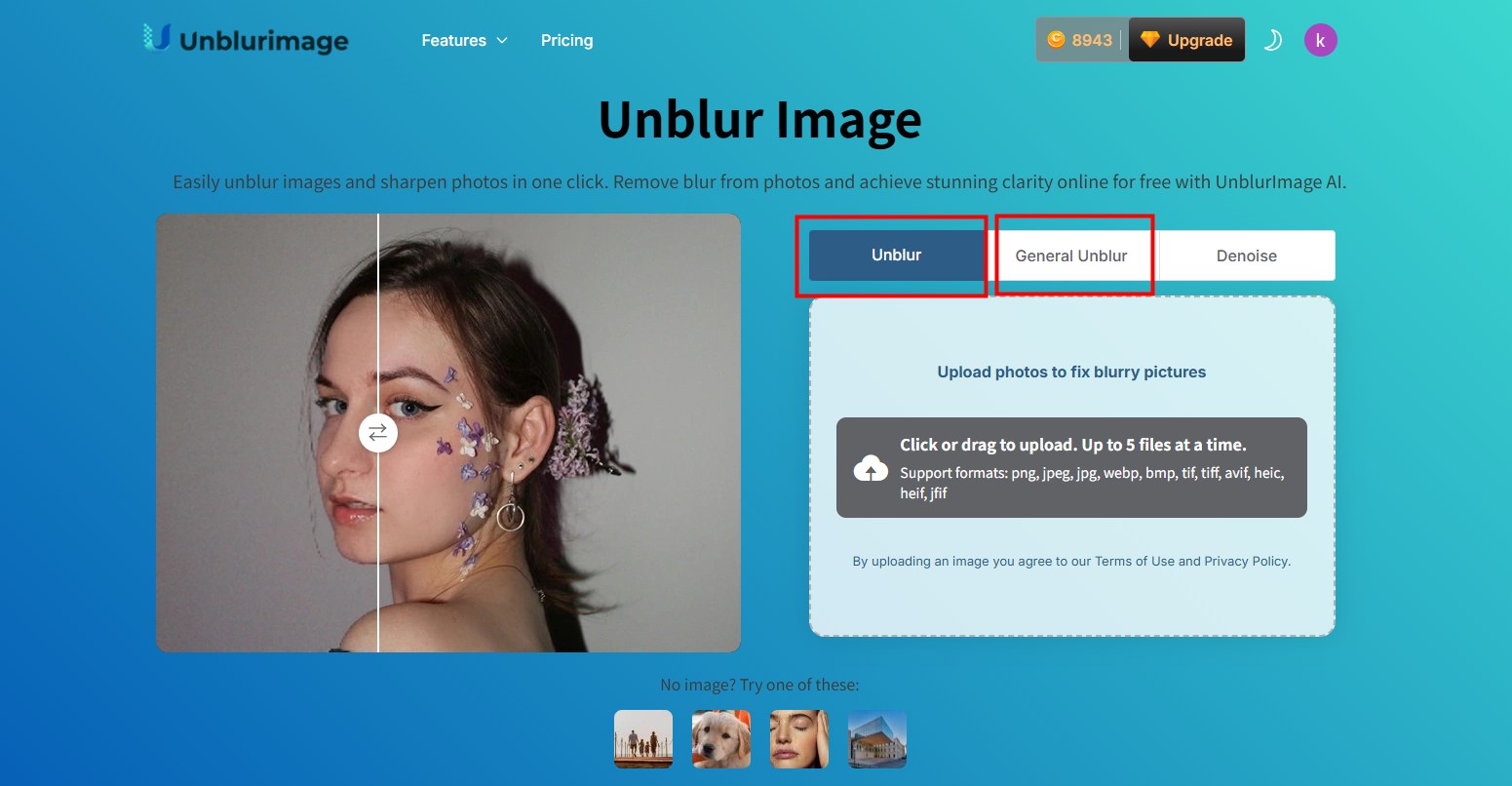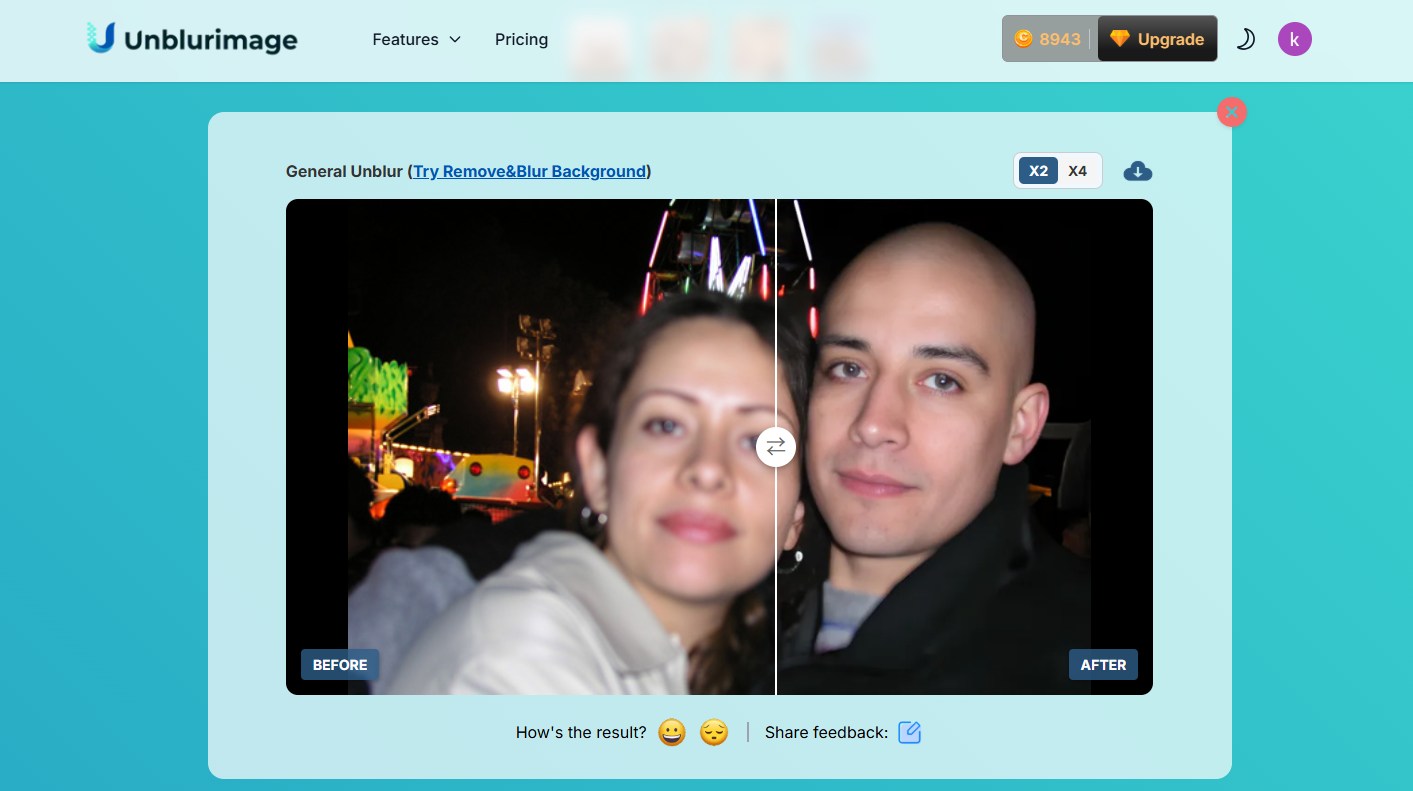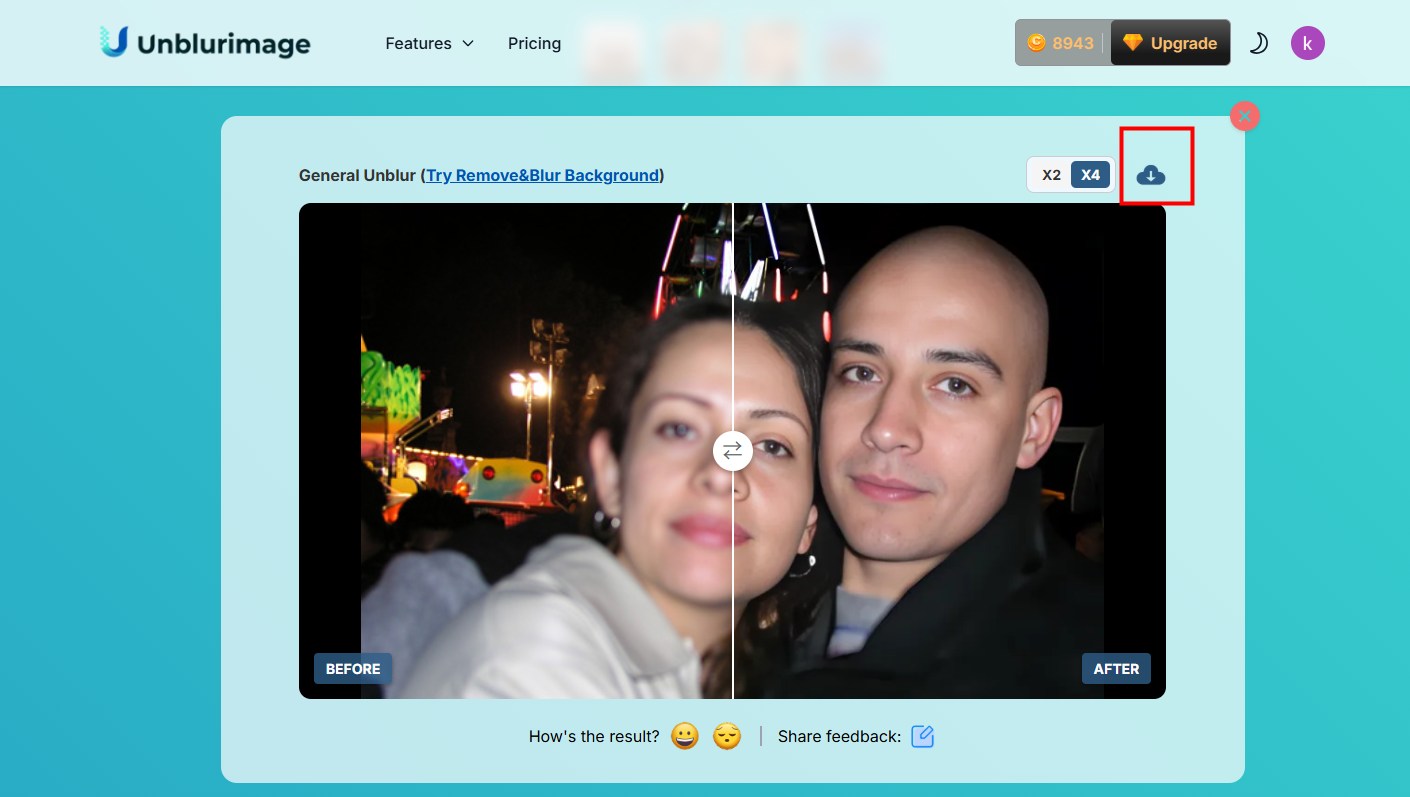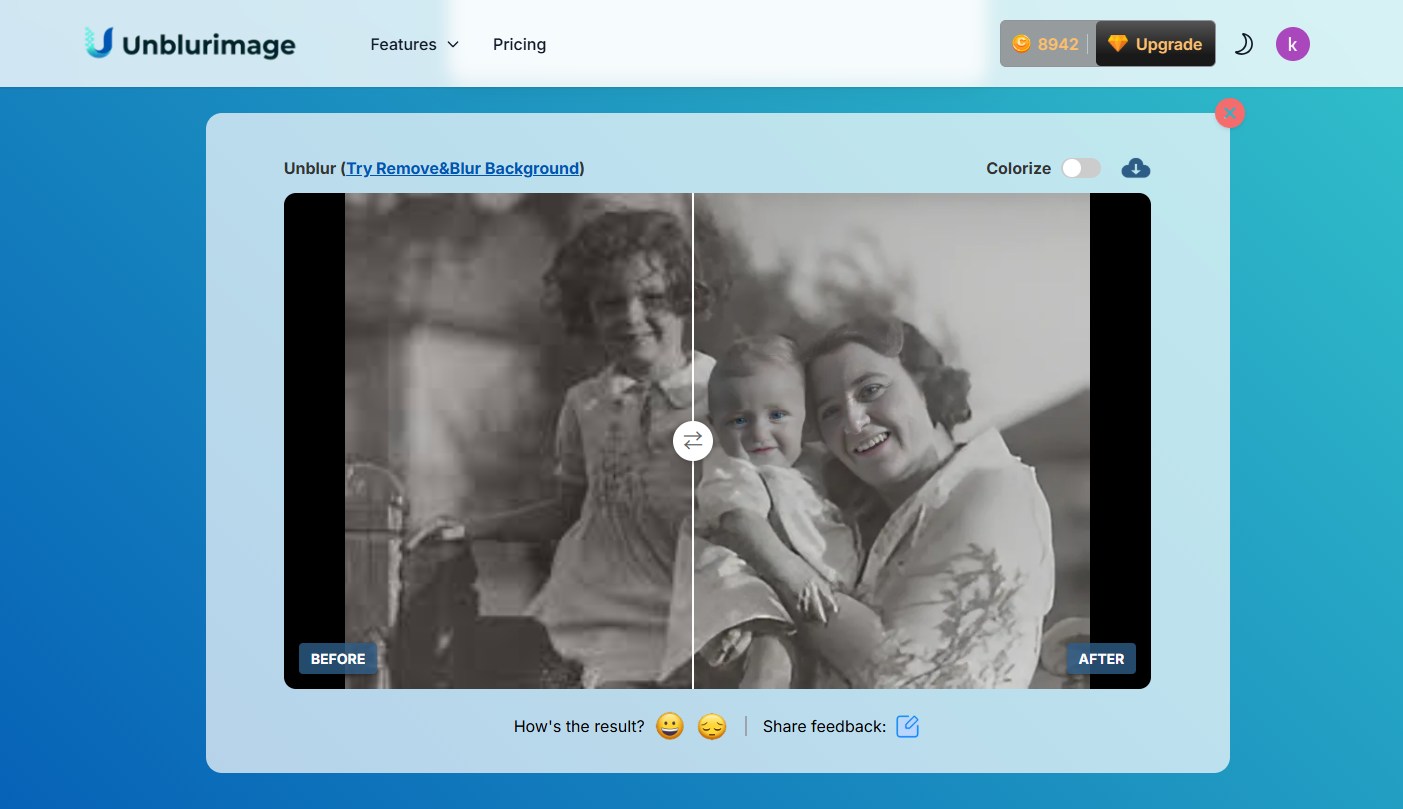Why Do My Photos Always Turn Out Fuzzy?
Have you ever asked, “Why do my photos always turn out blurry?” Whether it’s a scenic landscape, a family moment, or an important document, dealing with fuzzy, unclear photos can be incredibly frustrating. But you're not alone—and the good news is, you don't need expensive software or photography skills to fix it.
In this comprehensive guide, we’ll explore the main reasons behind blurry images, how to make photo clearer, and the best AI unblur photo tools like Unblurimage.ai that help you unblur photo online—completely free, in seconds.
Why Do Images Get Blurry?
Blurry images can result from a wide range of factors. Here are the most common reasons:
1. Motion Blur
If your camera or the subject moves while the shutter is open, the result is a streaked or fuzzy photo.
2. Focus Issues
If the camera focuses on the wrong part of the scene or fails to focus at all, the image will appear soft or fuzzy.
3. Low Light Conditions
In dim environments, cameras use slower shutter speeds to capture more light, increasing the chance of motion blur.
4. Dirty Lens
A smudged or dirty lens can distort the image and lead to blurry pictures.
5. Camera Quality
Lower-end smartphones or cameras may lack the hardware needed to capture crisp, high-resolution images.
What Can Cause Pictures to Become Blurry?
| Cause | Description |
|---|---|
| Camera Shake | Shaky hands or movement during capture |
| Wrong Focus Point | Focus not on the subject but background |
| Dirty Lens | Fingerprints or dust interfering with light |
| Poor Lighting | Not enough light to properly expose the image |
| Digital Zoom | Loss of detail when zooming in digitally |
| Compression Artifacts | Loss of quality from too much image compression |
Understanding the cause is the first step to fixing blurry photos.
Factors to Pay Attention to When Taking Pictures
Understanding the science behind photography can greatly improve your ability to take clear, crisp images. Here’s a breakdown of the core photographic principles and how to balance them:
| Factor | Why It Matters |
|---|---|
| Shutter Speed | The shutter controls how long light hits the camera sensor. A fast shutter speed (e.g., 1/1000s) captures motion but lets in less light, potentially making the image darker. A slow shutter speed (e.g., 1/30s) captures more light but is prone to motion blur if the camera or subject moves. To balance: use a faster shutter speed for action and add lighting or raise ISO to compensate for reduced brightness. |
| ISO Setting | ISO determines the camera’s sensitivity to light. A higher ISO (e.g., 1600 or 3200) helps in low light but introduces noise, making the photo look grainy. Lower ISO (e.g., 100 or 200) produces cleaner images in good lighting. The trick is to use the lowest ISO that still allows proper exposure. |
| Aperture (f-stop) | Aperture controls how much light enters through the lens and also affects depth of field (how much of the image is in focus). A wider aperture (e.g., f/1.8) creates a shallow depth of field and brighter images, perfect for portraits. A narrow aperture (e.g., f/11) keeps more of the scene sharp, ideal for landscapes. |
| Lighting | Natural daylight offers the best clarity. Poor lighting often forces the camera to slow shutter speed or raise ISO, increasing the chances of blur and noise. To counter this, shoot in well-lit areas or use external lighting like a flash or LED. |
| Focal Length & Distance | Longer focal lengths (telephoto) magnify far subjects but also amplify camera shake and noise. Shooting from a distance or zooming in often requires faster shutter speeds and image stabilization. If you're far from the subject, brace your arms or use a tripod to stabilize the shot. |
| Focus Mode | Most cameras offer Auto, Manual, and Continuous focus. Auto-focus might lock onto the wrong area (like the background), resulting in blur. Tap or manually select the subject to ensure the correct part of the image is sharp. |
Mastering these elements and learning how they interact—especially how shutter speed, aperture, and ISO form the "exposure triangle"—will give you more control and improve your chances of capturing a sharp, professional-looking photo.
How to Take a Clear Picture
Want to prevent blurry photos from happening in the first place? Here are some tips:
1. Use Both Hands
Stabilize the camera by holding it with both hands. If possible, use a tripod.
2. Focus Before You Shoot
Tap on the screen (for smartphones) to focus on the subject.
3. Clean Your Lens
Use a microfiber cloth to wipe the lens before every shot.
4. Enable Image Stabilization
Many cameras have built-in stabilization features—make sure they’re turned on.
5. Use Adequate Lighting
Always try to shoot in good lighting conditions. Natural daylight is best.
How to Save Pictures Without Losing Quality
- Avoid Excessive Compression: Save in formats like PNG or high-quality JPEG.
- Use Editing Software Wisely: When editing, save new versions instead of overwriting the original.
- Avoid Repeated Downloads: Repeated uploads/downloads on social media can degrade quality.
How to Fix Blurred Pictures
If you've already taken a blurry photo, don’t worry—you still have options to improve it. One of the easiest ways is to use Unblurimage.ai's unblurring features.
Unblurimage.ai’s Unblur Features
What is Unblurimage.ai?
Unblurimage.ai is a free AI-powered image enhancement tool designed to help users fix blurry, pixelated, or low-quality photos with just a few clicks. Whether you're dealing with motion blur, poor focus, or old family portraits, Unblurimage.ai uses advanced artificial intelligence to analyze and restore images quickly and accurately.

The platform offers a variety of features tailored for different enhancement needs, including:
- Unblur and General Unblur for correcting blurry photos
- Old Photo Restoration to fix and colorize vintage images
- AI Denoise for removing grain and noise
- Image Upscaler and Sharpener for improving resolution and sharpness
- Background Remover for professional-looking edits
With its clean interface, fast processing, and no signup required for basic use, Unblurimage.ai is ideal for anyone looking to make their photos clearer—no editing experience needed.

1. Unblur Function
This feature is designed for photos with a high degree of blurring or serious damage. It can partially redraw areas of the photo using advanced AI algorithms. However, due to the complexity, the results may not always be consistent.
- Best For: Severely blurred or old photos
- Changes to Original: High
- Stability: Medium


2. General Unblur Function
This option makes smaller corrections and is ideal for users who prefer to retain the original look of the image while improving clarity.
- Best For: Slightly blurred images
- Changes to Original: Low
- Stability: High


Feature Comparison Table
| Feature | Unblur | General Unblur |
|---|---|---|
| Ideal Use Case | Severe blur | Minor blur |
| Image Redraw | Partial | Minimal |
| Stability | Medium | High |
| Level of Change | High | Low |
Recommendation
If the Unblur function feels too aggressive or inconsistent, try the General Unblur function for a more stable and subtle enhancement.
Step-by-Step: How to Unblur Photos with Unblurimage.ai
- Visit Unblurimage.ai
- Choose the Unblur Image tool
- Upload your fuzzy photo
- Select either Unblur or General Unblur
- Wait for the AI to process the image
- Download your clearer image

It’s that simple to make photo clearer in seconds.
What Else Can Unblurimage.ai Do?
Besides unblurring photos, Unblurimage.ai offers a range of useful tools:
1. Old Photo Restoration & Coloring
Bring your old black-and-white or damaged photos back to life. This tool repairs cracks, fades, and colorizes your vintage pictures.

2. AI Denoise Image Function
Removes noise and graininess from low-quality or high-ISO photos, making the picture appear sharper and more polished.

3. Full Image Enhancement Suite
Unblurimage.ai includes:
- Image Upscaler
- Sharpener
- AI Color Enhancer
- Background Remover
With these features, you can address almost any image clarity problem, whether it's due to poor resolution, noise, or outdated prints.
Conclusion
Fuzzy photos don’t have to be a permanent problem. Whether you’re dealing with motion blur, poor focus, or noisy lighting, the key is knowing how to prevent issues during capture and how to fix blurry pictures after the fact.
With smart, user-friendly tools like Unblurimage.ai, you can easily unblur photo free, make photo clearer, and even restore your cherished memories. Give both the Unblur and General Unblur tools a try to find which one best meets your needs. And if you’re looking to go beyond just unblurring, explore old photo restoration, AI denoise, and more—all under one roof.
Ready to see your pictures in a whole new light?
Try Unblurimage.ai today.
Tool-Specific Questions
How can I make photo clearer?
Use online AI tools like Unblurimage.ai to enhance image sharpness without needing Photoshop skills.
Is there a way to unblur photo free?
Yes, Unblurimage.ai offer free unblur features for basic use.Users can use our image deblurring feature 6 times a day for free!And Unblurimage.ai supports batch blur removal.
What causes blurry pictures the most?
Motion blur and focus errors are the two most common causes of fuzzy photos.
Can I fix blurry pictures taken from old phones?
Absolutely. The Unblur function in Unblurimage.ai is excellent for handling older, low-resolution photos.
Will the AI redraw my image completely?
The Unblur function may partially redraw sections to restore detail. If you prefer minimal change, use General Unblur.
Does image size matter when unblurring?
Yes. Higher-resolution images usually result in better enhancement quality.
Can I restore old family photos?
Yes! Use the Old Photo Restoration tool on Unblurimage.ai to repair and colorize old family portraits.








